Canadian Pacific Line Fleet List
Fleet List of the Canadian Pacific Line Showing Ownership, Nationality, Name of Ship, Year Placed in Service, and Gross Tonnage. Gross tonnage equals cubic feet of all enclosed space divided by 100. Notations Regarding the Ship (if any), Such as Previous Name or Renaming, are shown after the Gross Tonnage.
CANADIAN PACIFIC LINE
Canadian Pacific Steamships, Ltd.
(British)
Established their trans-Pacific service in 1887. However, it was not until 1903, through the purchase of the Beaver Line fleet from Elder, Dempster & Co., that they entered the trans-Atlantic trade.
- Duchess of Atholl (1928) 20,119
- Duchess of Bedford (1928) 20,123
- Duchess of Richmond (1928) 20,022
- Duchess of York (1929) 20,021
- Empress of Asia (1913) 16,909
- Empress of Australia (1914) 21,833
- Empress of Australia (1924) 19,665
- Empress of Britain (1906) 14,189
- Empress of Britain (1931) 42,348
- Empress of Britain (1955) 25,516
- Empress of Canada (1922) 21,517
- Empress of Canada (1928) 20 325
- Empress of Canada (1960) 27,500
- Empress of China (1890) 5,947
- Empress of China (1914) 21,816
- Empress of England (1957) 25,585
- Empress of France (1913) 18,357
- Empress of France (1928) 20,448
- Empress of India (1889) 5,943
- Empress of India (1908) 16,992
- Empress of Ireland (1906) 14,191
- Empress of Japan (1890) 5,940
- Empress of Japan (1930) 26,032
- Empress of Russia (1913) 16,810
- Empress of Scotland (1905) 25,160
- Empress of Scotland (1930) 26,313
- Grampian (1907) 10,920
- Lake Champlain (1900) 7,392
- Lake Erie (1900) 7,550
- Lake Manitoba (1901) 9,674
- Lake Michigan (1901) 9,240
- Marburn (1900) 10,743
- Marglen (1898) 10,417
- Marloch (1904) 10,687
- Marvale (1907) 11,438
- Melita (1918) 15,183
- Metagama (1915) 12,420
- Milwaukee (1897) 7,317
- Minnedosa (1918) 15,186
- Missanabie (1914) 12,469
- Monmouth (1900) 4,078
- Montclam (1897) 5,505
- Montcalm (1921) 16,418
- Montclare (1922) 16,314
- Monteagle (1899) 6,955
- Monterey (1897) 5,478
- Montezeuma (1899) 7,345
- Montfort (1899) 7,087
- Montlaurier (1908) 16,992
- Montnairn (1908) 17,282
- Montreal (1900) 8,644
- Montreal (1906) 9,720
- Montrose (1897) 7,207
- Montrose (1922) 16,402
- Montroyal (1906) 15,646
- Mount Royal (1898) 7,998
- Mount Temple (1901) 7,656
- Ruthenia (1900) 7,392
- Tartar (1883) 4,425
- Tunisian (1900) 10,576
- Tyrolia (1900) 7,535
Duchess of Atholl (1928) Canadian Pacific Line
Built by Wm. Beardmore & Co., Glasgow, Scotland. Tonnage: 20,119. Dimensions: 581' x 75' (601' o.l.). Steam turbines. Two masts and two funnels. Passengers: 580 cabin, 480 tourist, 510 third. Launched: November 1927. Maiden voyage: Liverpool-Quebec-Montreal, July 13, 1928. Fate: Torpedoed and sunk in the South Atlantic, while bound from the Near East to England, October 10, 1942. Sister ships: Duchess of Bedford, Duchess of Richmond and Duchess of York.
Duchess of Bedford (1928) Canadian Pacific Line
Built by John Brown & Co., Clydebank, Glasgow, Scotland. Tonnage: 20,123. Dimensions: 581' x 75' (601' o.l.). Twin- screw, 18 knots. Steam turbines. Two masts and two funnels. Launched: January 25, 1928. Maiden voyage: Liverpool-Quebec-Montreal, June 1, 1928. Renamed: Empress of France (1948). Sister ships: Duchess of Atholl, Duchess of Richmond and Duchess of York.
Duchess of Richmond (1928) Canadian Pacific Line
Built by John Brown & Co., Clydebank, Glasgow, Scotland. Tonnage: 20,022. Dimensions: 581' x 75' (601' o.I.). Propulsion: Twin-screw, 18 knots. Steam turbines. Masts and Funnels: Two masts and two funnels. Maiden voyage: Liverpool-St. John, N. B., March 15,1929. Renamed: Empress of Canada (1947). Fate: Destroyed by fire at dock in Liverpool, January 25, 1953. Refloated in March 1954. Broken up for scrap in Italy, afterwards. Sister ships: Duchess of Atholl, Duchess of Bedford and Duchess of York.
Duchess of York (1929) Canadian Pacific Line
Built by John Brown & Co., Clydebank, Glasgow, Scotland. Tonnage: 20,021. Dimensions: 581' x 75' (601' o.l). Twin- screw, 18 knots. Steam turbines. Two masts and two funnels. Launched: September 28, 1928. Maiden voyage: Liverpool-St. John, March 22, 1929. Regular service: Liverpool-Quebec-Montreal. Fate: Sunk by high flying Focke Wolfe bombers in the Atlantic, off the Spanish coast, July 11, 1943, with the loss of 11 lives. Sister ships: Duchess of Atholl, Duchess of Bedford and Duchess of Richmond.
Empress of Asia (1913) Canadian Pacific Line
Built by Fairfield Shipbuilding and Engineering Co., Ltd., Govan, Scotland. Tonnage: 16,909. Dimensions: 570'x 68' (590' O.I.). Propulsion: Quadruple-screw, 20 knots. Turbines. Masts and Funnels: Two masts and three funnels. Keel laid: December 4, 1911. Launched: November 23, 1912. Completed in May 1913. Made a trial speed of 21.43 knots. Speed Records: Did a trans-Pacific crossing from Yokohama in 9 days, 2 hours, 44 minutes in 1914. Fate: Sunk by enemy action off Singapore on February 5, 1942. Sister ship: Empress of Russia. Design Notes: The first large liners to have cruiser sterns.
Empress of Australia (1914) Canadian Pacific Line
This Ship Sailed as the RMS Empress of Australia from 1922–1952
Built by A. G. "Vulkan" Werke, Stettin, Germany. Tonnage: 21,833. Dimensions: 588' x 75' (615' o.l.). Twin-screw, 19 knots. Steam turbines. Two masts and three funnels. Passengers: 400 first, 150 second, 630 third. Services: (a) Trans-Pacific, (b) Trans-Atlantic. Made her first Southampton-Cherbourg-Quebec-Montreal sailing in June 1927. Note: Launched as the Tirpitz (Hamburg-American Line), December 20, 1913. Construction work was held up during the first part of First World War, but in 1916 the Kaiser ordered her to be completed as a royal yacht in which to receive the Allied naval fleets in the event the Germans were victorious. However, such not being the case, this beautiful liner was ceded to Great Britain in 1919. Sale: Sold to Canadian Pacific Line in 1922. After being re-engined was able to make 22.4 knots. Passengers: 400 first class, 150 Tourist Class, 635 third class. Crew: 520 Officers and Crew Members.War Service: Converted to Troopship during World War II. Korean War Service: Operated as Troop Ship until 1952. Fate: Sold to British shipbreakers in May 1952. Previously Named: Empress of China (only for a brief time in 1921), ex-Tirpitz (1914-1921).
Empress of Australia (1924) Canadian Pacific Line
This Ship Operated as the RMS Empress of Australia from 1953–1956
Built by Cammell, Laird & Co., Birkenhead, England. Tonnage: 19,665. Dimensions: 552' x 71' (574' o.l.). Twin- screw, 16 knots. Steam turbines. Two masts and one funnel. Passengers: 220 first, 444 tourist. Note: Purchased as a replacement for the destroyed Empress of Canada. First voyage: Liverpool Quebec-Montreal, April 28, 1953. Sale: Sold to Grimaldi Line. Fate: Wrecked of the Coast of France near Cannes, Refloated and broken up at La Spezia, Italy in 1962. Renamed: Venezuela (1956-1962). Previous Name: De Grasse (1924-1953).
Empress of Britain (1906) Canadian Pacific Line
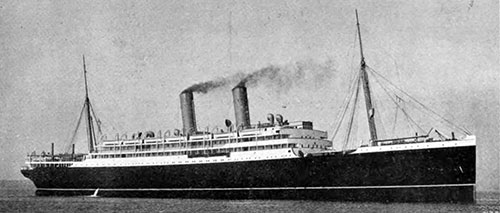
Built by Fairfield Shipbuilding & Engineering Co., Glasgow, Scotland. Tonnage: 14,189. Dimensions: 548' x 65' (570' O.I.). Propulsion: Twin-screw, 20 knots. Quadruple expansion engines. Masts and Funnels: Two masts and two funnels. Passengers: 310 first, 350 second, 800 third. Maiden voyage: Liverpool Quebec, May 5, 1906. Note: First "Empress" of the North Atlantic service. Made the Liverpool-Halifax run in 5 days, 18 hours, 18 minutes. World War I Service: Converted to auxiliary cruiser. Post War Service: Resumed regular service in March 1919. Service speed listed as 18 knots. Renamed: Montroyal (1924). Fate: Sold to Norwegian shipbreakers in April 1930. Sister ship: Empress of Ireland.
Empress of Britain (1931) Canadian Pacific Line
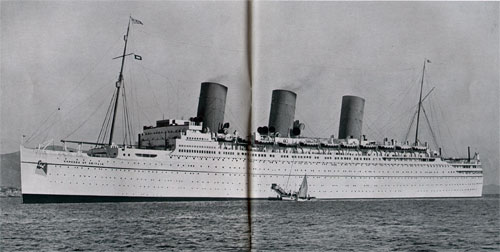
Built by John Brown & Co., Clydebank, Glasgow, Scotland. Tonnage: 42,348. Dimensions: 733' x 97' (758' o.l.). Propulsion: Quadruple-screw, 24 knots. Steam turbines. Masts and Funnels: Two masts and three funnels. Top of masts were 208 feet above water line. Funnels measured 27 feet across at widest part and 35 feet fore and aft. Cost $15,000,000 to build. Passengers: 452 first, 260 tourist, 470 third. Laid down: November 28, 1928. Launched, June 11, 1930. Maiden voyage: Southampton-Cherbourg-Quebec, May 27, 1931. Spent much time as a cruise ship. Fate: Disabled by German bombers off the Irish coast, October 26, 1940, and two days later, on the 28th, she was sunk by German submarine "U-32" while being towed. The largest Allied liner lost in World War II.
Empress of Britain (1955) Canadian Pacific Line
Built by Fairfield Shipbuilding & Engineering Co., Glasgow, Scotland. Tonnage: 25,516. Dimensions: 600' x 85' (640' o.l.). Propulsion: Twin-screw, 20 knots. Two steam turbines. Masts and Funnels: Single mast and one funnel. Laid down: September 30, 1953. Launched: June 22, 1955. Maiden voyage: Liverpool- Quebec-Montreal, April 19, 1956. Sister ship: Empress of England. Similar to: The new (1961) Empress of Canada.
Empress of Canada (1922) Canadian Pacific Line
Built by Fairfield Shipbuilding Co., Glasgow, Scotland. Tonnage: 21,517. Dimensions: 627' x 77' (653' o.l.). Twin- screw, 20 knots. Eight steam turbines. Two masts and three funnels. Note: In trans-Atlantic service for only a short time, as she was transferred to the trans-Pacific trade. Fate: Torpedoed and sunk, March 13, 1943.
Empress of Canada (1928) Canadian Pacific Line
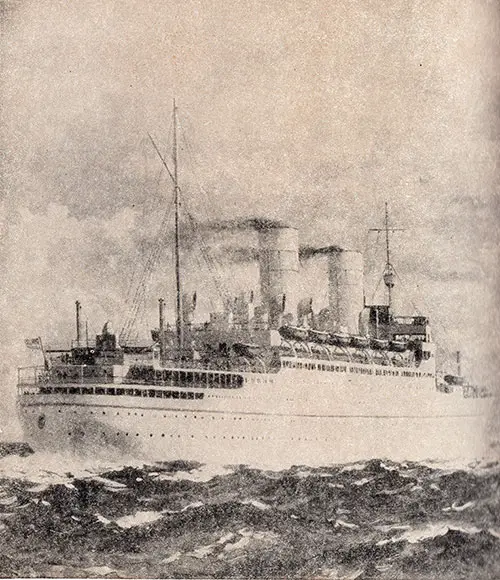
Sailed as Empress of Canada 1947-1953
Built by John Brown & Co., Clydebank, Glasgow, Scotland. Tonnage: 20,325. Dimensions: 581' x 75'. Twin-screw, 18 knots. Steam turbines. Two masts and two funnels. Modifications: Speed increased to 20 knots. Refitted after war service, 1946. First voyage as Empress of Canada was in July 1947. Accommodation for 400 first class and 300 tourist. Fate: Destroyed by fire at her Liverpool dock, January 25, 1953. The capsized burned out hulk was later refloated and in September 1954 was towed to Italy to be broken up for scrap. Previously Named: Duchess of Richmond (1928-1947). Sister ship: Empress of France.
Empress of Canada (1960) Canadian Pacific Line
Built by Vickers-Armstrongs, Ltd., Walker-on-Tyne, Newcastle, England. Tonnage: 27,500. Dimensions: 650' x 86'. Twin-screw, 21 knots. Steam turbines. Single mast and one funnel. Laid down, January 27, 1959. Launched: May 10, 1960. Passengers: 200 first and 860 tourist. Maiden voyage in spring of 1961. Running mates: Empress of Britain and Empress of England.
Empress of France (1913) Canadian Pacific Line
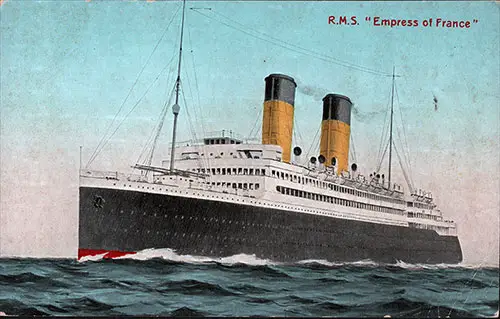
Vintage Postcard Features a Color Painting of the RMS Empress of France (1913) at Sea. The RMS Empress of France, formerly SS Alsatian, was an ocean liner built in 1913-1914 by William Beardmore and Company at Glasgow in Scotland for Allan Line. The ship's service history encompasses 99 trans-Atlantic voyages, 5 trans-Pacific voyages, and 8 other cruises in addition to her war service. This ship was the first North Atlantic liner with a cruiser stern. The vessel was an 18,481 gross tonnage ship, length 571.4 feet x beam 72.4 feet, two funnels, two masts, four propellers, and 18 knots. Her initial configuration provided accommodation for 287 1st class, 504 2nd class, and 848 3rd class passengers. | GGA Image ID # 15b1c9249d
Sailed as Empress of France from 1919 to 1931
Built by Wm. Beardmore & Co., Glasgow, Scotland. Tonnage: 18,357. Dimensions: 571' x 72' (600' o.l.). Quadruple- screw, 19knots. Steam turbines. Two masts and two funnels. Passengers: 287 first, 505 second, 848 third. First voyage as Empress of France Liverpool to Quebec, November 14, 1919. World Cruise: Made a world cruise from New York in 1923. Other Service: Placed in trans-Pacific service in December 1928 for a year. Last voyage: Southampton-Quebec, October 2, 1931. Fate: Laid up until scrapped in 1935. Previously Named: Alsatian (1919).
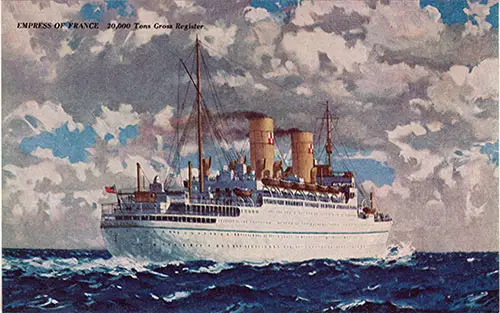
Empress of France, 30,000 Tons Gross Registry. SS Empress of France Passenger List, 15 September 1953. | GGA Image ID # 1167828a93
Empress of France (1928) Canadian Pacific Line
Built by John Brown & Co., Clydebank, Glasgow, Scotland. Tonnage: 20,448. Dimensions: 581' x 75' (601' o.l.). Twin- screw, 18 knots. Steam turbines. Two masts and two funnels. Post War Service: Reconditioned in 1947 after war service. For a time it was thought that she would be given the name Empress of India. However this contemplated name change did not take place and instead was renamed Empress of France. Re-entered the Liverpool-Quebec-Montreal service on September 1, 1948. Modifications: New modern funnels installed in 1958. Fate: Scrapped in 1961. Previously Named: Duchess of Bedford (1948). Sister ship: Empress of Canada.
Empress of Japan (1890) Canadian Pacific Line.
Built by Naval Construction and Armaments Co., Ltd., Barrow. England. Tonnage: 5,940. Dimensions: 455'x 51'. Propulsion: Twin-screw. 18 knots. Triple expansion entities. Masts and Funnels: Three masts and two funnels. Additional Features: Steel hull. Launched December 13, 1890. Attained a speed of 18.91 knots on her trials. Speed Records: It held the trans-Pacific speed record for a number of years until the Empress of Russia bettered it. In service Vancouver-Hong Kong 1891-1914 and 1915-1922. War Service: Served as auxiliary cruiser during the 1914-1915 period. Fate: Scrapped in l926. Sister ships: Empress of China and Empress of India.
Empress of Japan (1930) Canadian Pacific Line.
Built by Fairfield Shipbuilding and Engineering Co., Ltd. Govan, Scotland. Tonnage: 26,032. Dimensions: 644' x 83' (666' o.l.). Propulsion: Twin-screw, 22 knots. Turbines. Masts and Funnels: Two masts and three funnels. Speed Records: Her maximum trial speed was 22.38 knots. Held the trans-Pacific speed record. Made the crossing from Yokohama to Vancouver in 8 days, 6 hours, 27 minutes. Additional Features: From keel to navigating bridge 98 feet. Launched: She was launched on December 17, 1929. Completed in June 1930. Renamed: (a) Empress of Scotland (1942), (b) Hanseatic (1958).
Empress of Russia (1913) Canadian Pacific Line
Built by Fairfield Shipbuilding and Engineering Co., Ltd., Govan, Scotland. Tonnage: 16,810. Dimensions: 570' x 68' (590' 0.1.). Propulsion: Quadruple-screw, 20 knots. Turbines. Masts and Funnels: Two masts and three funnels. Keel laid: November 7, 1911. Launched: August 28, 1912. Completed: March 1913. Maximum Speed: Her maximum trial speed was 21.178 knots. Cost: about $25,000. Speed Records: Made a record trans-Pacific crossing from Yokohama to Race Rocks in 8 days, 18 hours, 31 minutes, at an average speed of 19.86 knots. Fate: Burned while refitting at Vickers-Armstrong Yard, Barrow-in-Furness, September 8, 1945. The hulk was broken up for scrap in 1946. Sister ship: Empress of Asia.
Empress of Scotland (1905) Canadian Pacific Line
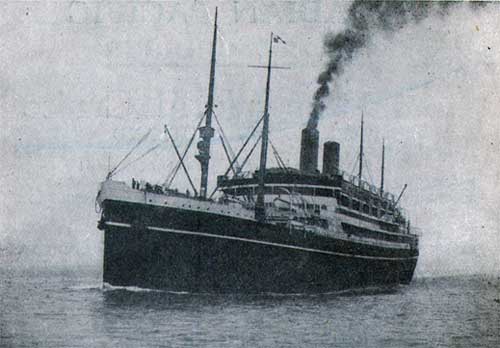
SS Empress of Scotland of the Canadian Pacific Line. SS Marburn Passenger List, 11 September 1925. | GGA Image ID # 1f24a61a2d
This Ship Sailed as the SS Empress of Scotland from 1922-1930
Built by A. G. "Vulkan", Stettin, Germany. Tonnage: 25,160. Dimensions: 677' x 77' (699' o.l.). Twin-screw, 18 knots. Quadruple expansion engines. Four masts and two funnels. CPL Acquistion: Acquired by Canadian Pacific Line in 1922 and reconditioned for their services. Passengers: 459 first, 478 second, 536 third. Fate: Sold for scrap in November 1930, but caught fire on December 10th, at the shipbreakers yard at Blyth. A second fire broke out on May 6, 1931. Completely dismantled by October 1931. Previous Name: Kaiserin Auguste Victoria.
Empress of Scotland (1930) Canadian Pacific Line
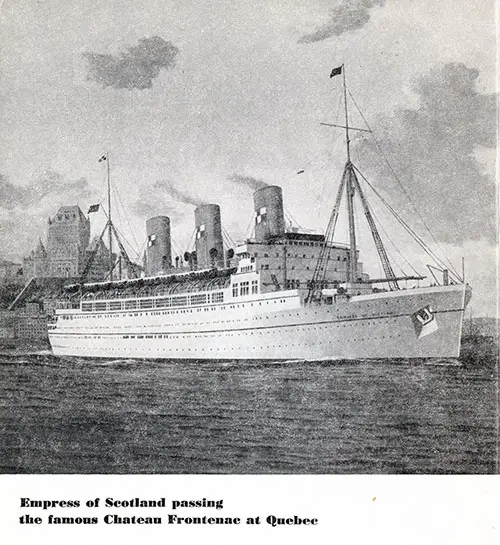
The Empress of Scotland Passing the Famous Chateau Frontenac at Québec. RMS Empress of Scotland Passenger List, 30 May 1950. | GGA Image ID # 1f2423a534
This Ship Sailed as the SS Empress of Scotland from 1942-1957
Built by Fairfield Shipbuilding & Engineering Co., Glasgow, Scotland. Tonnage: 26,313. Dimensions: 644' x 83' (666' O.I.). Twin-screw, 21 knots. Steam turbines. Two masts and three funnels. Post War Service: After war service was reconditioned in 1948 for trans-Atlantic trade. First Liverpool-Québec sailing was made in May 1950, completing the crossing from Greenock to Father Point, Quebec, in 5 days, 36 minutes. Sale: Sold to German owners in January 1958. Renamed: Hanseatic (1958-1966) Hamburg Atlantic Line. Previous Name: Empress of Japan (1930-1942). Fate: Destroyed by fire at New York City harbor, 7 September 1966.
Grampian (1907) (a) Allan Line, (b) Canadian Pacific Line
Built by Alexander Stephen & Sons, Ltd., Glasgow, Scotland. Tonnage: 10,920. Dimensions: 485' x 60'. Propulsion: Twin-screw, 15 knots. Triple expansion engines. Masts and Funnels: Two masts and one funnel. Passengers: 210 first, 250 second, 1,000 third. Service: Glasgow-Quebec-Montreal. Ownership Change: Taken over by Canadian Pacific Line in 1917. Retained her name in their service. Fate: Vessel was laid up in 1922. Scrapped in 1926. Sister ship: Hesperian. Similar to Corsican.
Marburn (1900) Canadian Pacific Line
Built by Alexander Stephen & Sons, Ltd., Glasgow, Scotland. Tonnage: 10,743. Dimensions: 500' x 59'. Propulsion: Twin-screw, 16 knots. Triple expansion engines. Masts and Funnels: Two masts and one funnel. CPL Maiden Voyage: First sailing as Marburn, Liverpool to St. John, New Brunswick, November 17, 1922. Fate: Sold to Italian shipbreakers in August 1928. Previous Names: Tunisian (1900-1922).
Marloch (1904) Canadian Pacific Line
Built by Workman, Clark & Co., Belfast, Ireland. Tonnage: 10,687. Dimensions: 517' x 60' (540' o.l.). Triple-screw, 15 knots. Steam turbines. Two masts and one funnel. New steam turbines in 1922. Passengers: 418 cabin and 566 third class. CPL Maiden Voyage: First Atlantic voyage as Marloch, December 20, 1922. Fate: Broken up for scrap in 1930. Previous Names: Victorian (1904-1922).
Melita (1918) Canadian Pacific Line
Built by Barclay, Curie & Co., Glasgow, Scotland. Tonnage: 15,183. Dimensions: 520' x 67' (546' o.l.). Triple-screw, 16 knots. Triple expansion engines and one low pressure steam turbine. Two masts and two funnels. Passengers: 550 cabin and 1,200 third class. Service: Placed in England-Canada service. Sale: Sold to Italy in 1935. Renamed: Liguria (1935). War Service: First employed as a transport during Italian invasion of Ethiopia. Bombed at Tobruk in July 1940. Fate: Scuttled at Tobruk in January 1941. Refloated in August 1950; towed to Italy to be broken up for scrap. Sister ship: Minnedosa.
Metagama (1915) Canadian Pacific Line
Built by Barclay, Curie & Co., Glasgow, Scotland. Tonnage: 12,420. Dimensions: 500' x 64'. Twin-screw, 16 knots. Quadruple expansion engines. Two masts and two funnels. Passengers: 520 cabin and 1,200 third class. Maiden voyage: Liverpool-St. John, New Brunswick, March 26, 1915. Fate: Scrapped in Great Britain in 1934. Sister ship: Missanabie. Note: The first so called "Cabin" class steamships built for the Canadian Pacific Line.
Milwaukee (1897) Canadian Pacific Line
Built by Swan & Hunter, Ltd., Newcastle, England. Tonnage: 7,317. Dimensions: 470' x 56'. Propulsion: Single-screw, 12 knots. Triple expansion engines. Masts and Funnels: Two masts and one funnel. Note: Built for Beaver Line (Elder, Dempster and Co.). Launched, November 7, 1896. Placed in service to New Orleans. Also in London-Quebec-Montreal trade. Ownership Change: Transferred to Canadian Pacific Line ownership in 1903. Fate: Torpedoed and sunk 260 miles from Fastnet, August 31, 1918, with the loss of one life. Sister ship: Mount Royal.
Minnedosa (1918) Canadian Pacific Line
Built by Barclay, Curie & Co., Glasgow, Scotland. Tonnage: 13,972. (15,186 in 1925). Dimensions: 520' x 67' (546' o.l.). Propulsion: Triple-screw, 16 1/2 knots. Triple expansion engines and steam turbine. Masts and Funnels: Two masts and two funnels. Reconditioned by Cammell, Laird & Co., at Birkenhead in 1925. Maiden voyage: Liverpool-St. John, New Brunswick, December 6, 1918. Service: In regular service to Québec and Montréal. Sale Sold to Italy in 1935. Renamed: Piemonte (1935). She later served as the passenger liner Piemonte for Lloyd Triestino. Fate: Torpedoed and sunk at Messina in March 1944. Refloated in 1949, but found unfit for further service and was broken up for scrap. Sister ship: Melita. Note: The hulls of these passenger ships were laid down in 1914 for the Hamburg- American Line. However, when World War I commenced, construction was temporarily halted. The vessels were completed for the Canadian Pacific Line.
Missanabie (1914) Canadian Pacific Line.
Built by Barclay, Curie & Co., Glasgow, Scotland. Tonnage: 12,469. Dimensions: 500' x 64'. Propulsion: Twin-screw, 15 1/2 knots. Quadruple expansion engines. Masts and Funnels: Two masts and two funnels. Passengers: 520 cabin, 1,200 third class. Maiden voyage: Liverpool-Quebec-Montreal, October 2, 1914. Fate: Torpedoed and sunk 52 miles from Daunts Rock (Cobh) on September 9, 1918, with the loss of 45 lives. Sister ship: Metagama. Note: First Canadian Pacific liners designed as a “cabin class” ship.
Montcalm (1921) Canadian Pacific Line
Built by John Brown & Co., Clydebank, Glasgow, Scotland. Tonnage: 16,418. Dimensions: 549' x 70' (577' o.l.). Twin- screw, 17 knots. Steam turbines. Two masts and two funnels. Passengers: 540 cabin and 1,250 third. Maiden voyage: Liverpool-St. John, New Brunswick, January 17,1922. New single-reductioned geared steam turbines in 1929. Renamed : Wolfe (1939) British armed merchant cruiser. Converted to depot-ship at later date. Fate: Scrapped in 1952. Sister ships: Montclare and Montrose.
Montclare (1922) Canadian Pacifie Line
Built by John Brown & Co., Clydebank, Glasgow, Scotland. Tonnage: 16,314. Dimensions: 549'x 70' (577' o.l.). Propulsion: Twin-screw, 17 knots. Six steam turbines. Masts and Funnels: Two masts and two funnels. Maiden voyage: Liverpool-Quebec-Montreal, August 18, 1922. WWII Service: Served first as an armed merchant cruiser in World War II. Ownership Change: Sold to British Government in 1942. Converted to a submarine tender in 1946. She was not renamed by British Government. Fate: Scrapped in Great Britain, 1958. Sister ships: Montcalm and Montrose.
Montlaurier (1908) Canadian Pacific Line
The SS Montlaurier Sailed for the Canadian Pacific Line from 1923-1925
Built by J. C. Tecklenborg & Co., Geestemunde, Germany. Tonnage: 16,992. Dimensions: 590'x 68'. Propulsion: Twin-screw, 17 knots. Quadruple expansion engines. Masts and Funnels: Two masts and two funnels. First voyage as Montlaurier in May 1923. Incidents: Nearly destroyed by fire on April 15, 1925, while undergoing repairs in Cammell, Laird's yard at Birkenhead. Renamed: Montnairn (1925). Fate: Scrapped in 1931. Previous Names: Empress of India (1922), Prinz Friedrich Wilhelm (1920).
Montnairn (1908) Canadian Pacific Line
The SS Montnairn Sailed for the Canadian Pacific Line from 1925 to 1929.
Built by J. C. Tecklenborg & Co., Geestemunde, Germany. Tonnage: 17,282. Dimensions: 590'x 68' (613' o.l.). Propulsion: Twin-screw, 17 knots. Quadruple expansion engines. Masts and Funnels: Two masts and two funnels. Route: Hamburg-Southampton-Cherbourg-Cobh-Québec-Montréal and Montréal-Québec-Cherbourg-Southampton-Hamburg. Fate: Sold to Italian shipbreakers in December 1929, but not dismantled until 1931. Previously Named: Montlaurier (1922-1925), Empress of India (1921-1922), Prinz Friedrich Wilhelm (1907-1920).
Montrose (1922) Canadian Pacific Line
Built by Fairfield Shipbuilding & Engineering Co., Glasgow, Scotland. Tonnage: 16,402. Dimensions: 548' x 70' (576' o.l). Propulsion: Twin-screw, 17 knots. Steam turbines. Masts and Funnels: Two masts and two funnels. Passengers: 542 cabin and 1,268 third. Maiden voyage: Liverpool-Quebec-Montreal, May 5, 1922. Modifications: New steam turbines in 1931. Renamed: Forfar (1939) British Admiralty. Fate: Torpedoed and sunk by submarine "U-99" on December 2, 1940. Sister ships: Montcalm and Montclare.
Montroyal (1906) Canadian Pacific Line
Sailed for the Canadian Pacific Line as the SS Montroyal from 1924-1930
Built by Fairfield Shipbuilding & Engineering Co., Glasgow, Scotland. Tonnage: 15,646. Dimensions: 548' x 65' (570' O.I.). Propulsion: Twin-screw, 18 knots. Quadruple expansion engines. Masts and Funnels: Two masts and two funnels. Passengers: 600 cabin ana 800 third class. Services: Liverpool-Quebec-Montreal ; Antwerp-Southampton-Cherbourg-Quebec. Fate: Sold to Norwegian ship-breakers in June 1930. Previous Name: Empress of Britain (1906-1924).
Tunisian (1900) Allan Line
Built by Alexander Stephen & Sons, Ltd., Glasgow, Scotland. Tonnage: 10,576. Dimensions: 500' x 59'. Propulsion: Twin-screw, 16 knots. Triple expansion engines. Masts and Funnels: Two masts and one funnel. Passengers: 240 first, 220 second, 1,000 third. Maiden Voyage: Commenced her maiden voyage from Liverpool to Canada in April 1900. Ownership Transfer: Transferred to Canadian Pacific Line during World War I. Renamed: Marburn (1922). Fate: Scrapped in 1928. Sister ship: Bavarian
Smith, Eugene W., Passenger Ships of the World: Past and Present, Boston: George H. Dean Company, 1963.
